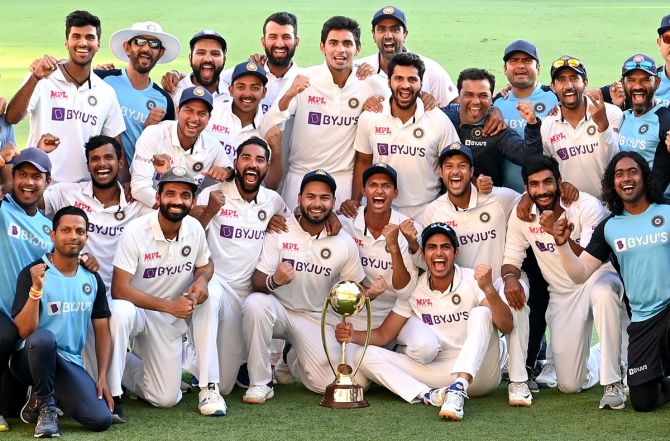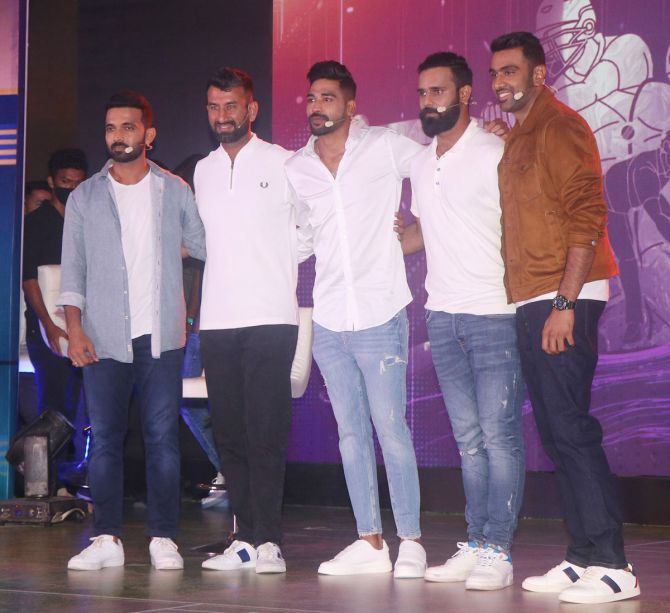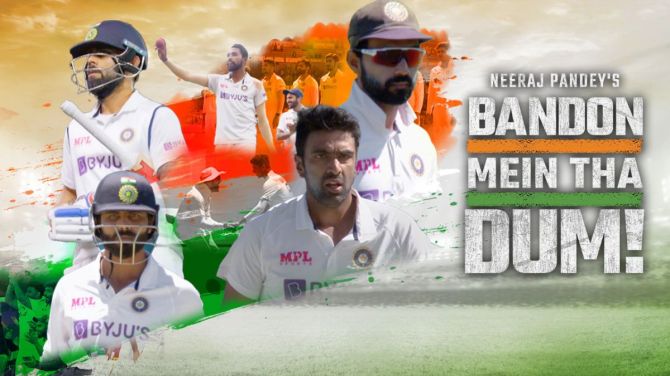Bandon Mein Tha Dum is about a team that hits rock-bottom, loses key players, has its global reputation shrink overnight, but despite all the setbacks, pulls off one of the greatest comeback victories in the history of international cricket, applauds Shailesh Karkera.

Bandon Mein Tha Dum is a retelling of India's cherished 2021 Tour of Australia which is widely considered to be one of the all-time greatest overseas test performances in the history of the nation.
The four-part series by Director Neeraj Pandey and narrated by Jimmy Shergill pays homage to the victory and shows us the Test series as it unfolded in front of the authors of the saga themselves -- leading players from both Team India and Australia -- as they narrate the events from their personal point of view.
Each of the four Test matches are covered individually in each of the four episodes, which themselves are named after James Bond movies. The final episode, named License to Kill, could either be a tribute to Rishabh Pant as Agent 007 or alternatively, a dig at the frustrated Aussie pacers who were ready to go to any lengths to dismiss Cheteshwar Pujara.
Set against the background of the COVID-19 pandemic, the story of this series is about the ultimate redemption arc, of a team that hits rock-bottom, loses key players, has its global reputation shrink virtually overnight, rakes up a massive injury list but despite all of the setbacks, refuses to back down against a formidable foe and pulls off one of the greatest comeback victories in the history of international cricket with what is essentially a second-string team.
Right off the bat, we are introduced to our protagonists, Team India -- held in their hotel rooms in forced quarantine, frustrated at the stringent Aussie protocols, training under restrictions and unsatisfied by the hospitality (or lack thereof) shown by the hosts.
Barely a few minutes into the narrative, we hear from the antagonists -- it's Australia of course, a cricket team who, since the late 1990s, have taken gamesmanship and transformed it into an art-form, the latest iteration being the 'Sandpaper Gate' scandal of 2018 and in Team Captain Tim Paine, we have our 'baddie-in-chief' as he immediately dismisses every complaint made by the visitors in his opening comments.
Test cricket has come a long way from its roots in Victorian England and exists today as a mere shadow of 'The Gentleman's Game' it once claimed to be. The editors have intentionally highlighted some of the uglier aspects from the matches which are cringe-inducing at times.
Aussie Pat Cummins very aptly remarks, "Sod the old days!" when asked about bowlers attacking tail-enders before we cut away to the footage from the first test of the pacer unleashing a short-pitched delivery that smashes into Mohammed Shami's forearm, thereby bringing the batter's tour to an abrupt and rather painful end.
By the end of the first episode, India suffer a humiliating defeat after being bowled out for 36 which is followed by a montage of dismissed batters making the walk of shame back to the pavilion with single digit scores.

With soon-to-be-daddy Virat Kohli heading for the airport to be with his family, morale is at an all-time low and the focus shifts on his deputy Ajinkya Rahane, who, traumatised by his own actions in the first Test and with the entire global cricketing media and punditry circles predicting a 4-0 blow-out in favour of the Aussies, explains how India has nothing to lose at this point and that "Our series begins from here".
While we get to learn how the team recovers from the early setback, we head on to the second episode which focuses on the recovery process. An emotional Rahane walks us through his perspective as team captain and eventually scores a spectacular first innings century that sets the basis for the eventual victory.
Rahane's comment to Shubman Gill when asked whether they should 'take it slow' in the second innings with the target within sight is legendary to say the least:
'Mai yahan khada rehene nahi aaya. Mai maarney aaya hoon (I have not come here to stand. I have come to hit)' -- Ajinkya Rahane.
By far, some of the best monologues and commentary on the series comes from Ravichandran Ashwin, who explains how he meticulously studies each batter for hundreds of hours before facing them on the pitch and like a modern-day soothsayer, walks us through the step-by-step process by which he manufactures certain dismissals.
On the other hand we have Rishabh Pant, one of the most polarising figures in modern day cricket, who, unlike Ashwin, has a simplistic view on most things both on and off the field and is what you get when a player hard-wired in T20 cricket takes to the five-day format. As Mohammad Siraj reveals, the entire Indian squad is on edge whenever Pant is on the crease.
If there was one quote that completely summarised the final two Tests/episodes, it was this hilarious line by Ashwin:
'There was Plan A. There was Plan B. There was Plan C... and then there was Rishabh's Plan' -- R Ashwin

The third Test starts off and it looks like the Aussies are back in the driver's seat. For a hot minute, the sport takes a back seat as Mohammed Siraj falls victim to racist abuse from a handful of spectators. It's a baptism by fire for the debutant Siraj who is still grieving from the recent loss of his father.
Eventually, the story of the third Test boils down to the final day and Team India's valiant attempt to salvage a draw despite all of the under-handed tactics used by Australia, reminding us once again why they are the baddies.
An injured Hanuma Vihari battles bravely through the pain and later we learn that he had suffered a Grade-2 hamstring tear and still somehow saved the game for India.
Pant misses out on a century by a whisker playing a rash shot after we learn that Pujara specifically advises him to 'take it slow'. Eventually even Rahane concludes that Pant is a wildcard best left to his own devices -- a critical call considering the series of events that unfold in the final Test at the Gabba.
On to the final Test and India's injury woes result in a record number of debutants taking the field in what has now become a David versus Goliath scenario against the hosts playing at a venue where they have been unbeaten for 34 long years, the Gabba.
One of the most hard-hitting scenes both literally and emotionally is the rough treatment meted out to Pujara as the Aussie pacers hammer the ball into his body time and again. Pujara's own commentary of the incidents is rather reserved and after inputs from Ashwin and Pant, one gets the feeling that he is enduring this pain and suffering for 'the greater good' of the Indian team.
Ultimately, everything boils down to Pant and his match-winning innings and he takes us through his decision-making process of attempting a boundary with three runs remaining -- a risky proposition that requires nerves of steel and while his explanation is not too convincing, his execution does the job.
Bandho Me Tha Dum is the insider perspective on what was a remarkable story to begin with and credit to Neeraj Pandey for seamlessly bringing both the team and the individual storylines together in a remarkable manner.
Bandho Me Tha Dum streams on Voot












 © 2025
© 2025